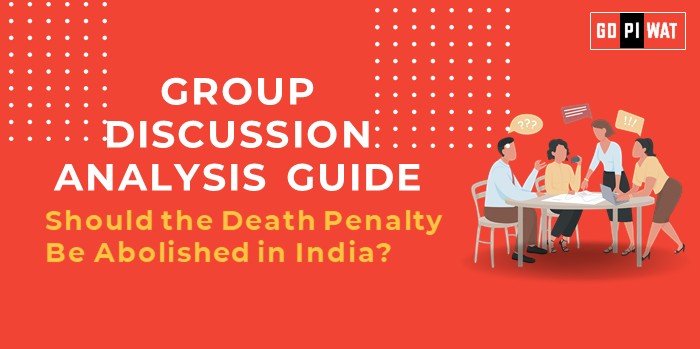body>
📋 Group Discussion (GD) Analysis Guide: Should the Death Penalty Be Abolished in India?
🌐 Introduction to the Topic
Opening Context: The death penalty remains one of the most debated issues globally, reflecting on justice, human rights, and state accountability. In India, it continues to evoke sharp divides among legal scholars, human rights activists, and policymakers.
Topic Background: India retains the death penalty for the “rarest of rare” cases as per the 1980 Bachan Singh case judgment. However, concerns about judicial errors, human rights, and international trends toward abolition drive the debate.
📊 Quick Facts and Key Statistics
- Current Retention: India is one of 55 countries still practicing the death penalty.
- Convictions: 165 individuals were sentenced to death in India in 2022, the highest in over two decades (Project 39A, 2023).
- Global Trends: 112 countries have abolished the death penalty for all crimes (Amnesty International, 2023).
- Judicial Errors: A study by NLU Delhi reveals a 65% reversal rate of death sentences on appeal in India.
🔑 Stakeholders and Their Roles
- Government: Frames laws and defends the death penalty for deterring heinous crimes.
- Judiciary: Balances the “rarest of rare” doctrine with human rights principles.
- Human Rights Organizations: Advocate for abolition, citing errors and human dignity.
- Victims’ Families: Often demand the death penalty as a measure of justice.
- Society: Reflects diverse opinions shaped by culture, religion, and morality.
🎯 Achievements and Challenges
✅ Achievements
- Maintains a deterrent effect in some high-profile cases.
- Provides closure to victims’ families in heinous crimes.
- Supported by significant public sentiment for justice.
⚠️ Challenges
- High reversal rates due to judicial inconsistencies.
- Risk of executing innocent individuals due to judicial errors.
- Ethical concerns surrounding state-sanctioned execution.
🌍 Global Comparisons
- Success: Norway abolished the death penalty in 1979, emphasizing rehabilitation.
- Challenges: The USA continues to grapple with racial biases in capital punishment.
📝 Structured Arguments for Discussion
- Supporting Stance: “The death penalty deters heinous crimes and ensures justice for victims.”
- Opposing Stance: “The risk of wrongful execution and the lack of deterrence make the death penalty unjustifiable.”
- Balanced Perspective: “While the death penalty may address extreme cases, systemic reform and alternatives like life imprisonment should be prioritized.”
💡 Effective Discussion Approaches
- Opening Approaches:
- “India’s 165 death sentences in 2022 highlight systemic flaws that warrant deeper scrutiny.”
- “Can justice justify the risk of wrongful execution? This is the crux of the death penalty debate.”
- Counter-Argument Handling:
- Use global examples like Norway’s focus on rehabilitation to counter pro-death penalty arguments.
- Highlight judicial inconsistencies and reversal rates as evidence of systemic flaws.
📈 Strategic Analysis of Strengths and Weaknesses
Strengths
- Deterrent value for heinous crimes.
- Public support ensures societal acceptance.
- Provides justice for victims’ families.
Weaknesses
- Risk of wrongful execution.
- Judicial inconsistencies lead to reversal rates.
- Fails as a proven deterrent in many cases.
Opportunities
- Reforms for fair trials and equitable justice.
- Promotion of life imprisonment as an alternative.
Threats
- Human rights violations tarnishing international reputation.
- Increasing societal polarization on the issue.
📚 Connecting with B-School Applications
- Real-World Applications:
- Policy-making implications and the role of advocacy in the legal system.
- Exploring ethical decision-making frameworks in governance and law.
- Sample Interview Questions:
- “How does the death penalty align with human rights values?”
- “Can India maintain deterrence without capital punishment?”
- Insights for B-School Students:
- Explore intersections of law, ethics, and policy for strategic management roles.
- Understand societal dynamics impacting governance and policy-making.


